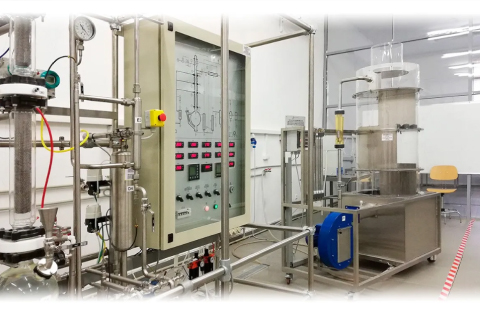
Pelatihan Pembuatan Website
The plan of investments in research and human resources started in 1984 and the intensive collaboration with Italian and foreign universities and with chemical, pharmaceutical and food-farming industries have enabled ELETTRONICA VENETA to introduce their renewed line of products for chemical engineering, with a right pride.
Products have been designed for their use in the technical institutes and universities that intend to enrich their equipment with pilot plants and laboratory apparatuses for implementing an up-to-date and complete testing programme.
All the products have been designed and manufactured according to some principles considered essential by our company:
- faithful reproduction of the industrial design, although on a reduced scale;
- use of industrial instruments (sensors, transducers, actuators) of the best trademarks available on the market (ABB, Schneider Electric, E&H, ecc.);
- particular care for the quality of materials for ensuring long lifetime and industrial standard with great use of stainless steel (supporting frameworks, tanks, pipes and valves) and of borosilicate glass (tanks and columns);
- application of the most advanced technologies of plant supervision and control;
- wide choice of sizes and of control types (manual, automated and computerized versions).
Thanks to these important characteristics our plants are also suitable for research and for small productions, consequently they are used in leading companies of chemical, pharmaceutical and food-farming sectors. All the plants (excepting the desk-type versions) are mounted on a wheeled framework of stainless steel for an easier shiftment and they are equipped with switchboard including automatic differential switch.
Most plants shown in this catalogue are available in three versions:
- Manual;
- Manual with data logging;
- Automated.
The models concerning the version with data logging are identified by the suffix “c”, whereas the models concerning the automated version are identifi ed by the suffi x “a”. For instance, as regards the distillation unit, the mod. UDC/EV concerns the manual version, the mod. UDCc/EV concerns the computerized version, whereas the mod. UDCa/EV concerns the automated version.
The manual version is not equipped with any automation system and it cannot be connected with any PC; process parameters can be read directly on the instruments included in the plant and on the control board and they can be controlled completely in manual way.
The computerized version too does not show any automated system, but its instruments are equipped with analog-output transmitter; an industrial data acquisition module, available in the switchboard, enables to acquire the process parameters merely with the connection of the serial cable of the equipment with a PC where the supervision software has been installed. Further details on supervision software will be available in the respective section of this catalogue.
The automated version is provided with all the functions of the computerized version, but it is also equipped with one or more microprocessor PID controllers that enable to control some process parameters automatically. Supervision is carried out by a PC via a SCADA software and it enables the operator to work with the plant without moving from his/her own workstation. Further details on supervision software will be available in the respective section of this catalogue. Besides being recommended for the study of chemical engineering, automated versions are particularly suitable also for the study of process control, as they represent an application to an actual process.
This catalogue classifies the plants according to unit operations and each section subdivides some models furtherly into 2 categories: “Medium” and “Large”. “Large” category includes the plants of bigger size and, consequently, of higher price; whereas “Medium” category includes the plants of smaller size.


